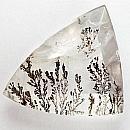|
|
||||||||||||||||
|
||||||||||||||||
|
||||||
|
|
|
|
Dendrites
in Quartz
(variety
of Manganese Oxides)
|
|
| | |
| Discovery year unknown; IMA status: Not Valid (trade name) | ||
|
| ||
|
More Information |
|
|
|
|
|
|
Dendrites
are a variety of Manganese Oxides. |
|
Synonyms: |
Dendrites, Manganese Dendrites, Manganese Oxides. Moss Agate |
|
View mineral photos: | |
|
|
|
|
More Information |
|
|
|
|
|
| |
|
|
|
|
Dendrites are often attributed to the mineral
Pyrolusite but testing by infra-red spectroscopy has
shown that no known manganese dendrites are Pyrolusite
but may consist of other similar black manganese oxides
such as Birnessite, Coronadite, Cryptomelane, Hollandite,
Romanèchite, Todoroite or other species. Potter and Rossman (1979) have found that infra-red
spectroscopy has been helpful in verifying some dendrite mineralogy.
See Potter
and Rossman 1979, Mineralogy of Manganese Dendrites and Coatings,
American Mineralogist, v. 64, p. 1219-1226. |
|
We
have not photographed our Dendrite
gems. Please
check back soon. |
